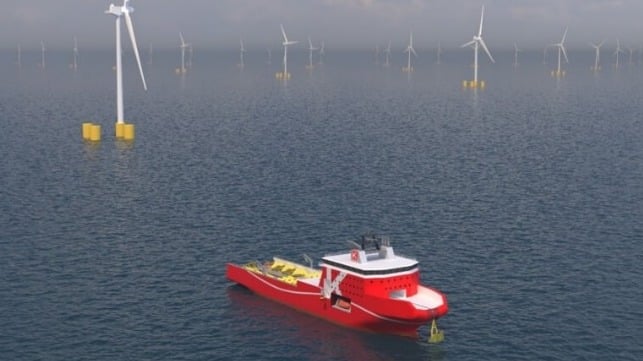Design Developed for Multi-Function Vessel for Floating Wind Turbine Farms

Japan’s “K” Line Wind Service working with shipbuilders Japan Marine United and Nihon Shipyard has developed designs for a new class of vessel specifically designed to support the development of floating offshore wind turbines. According to the companies, the concept is for a multi-functional floating offshore wind farm support vessel that would make the process of planning and installing floating wind turbines more efficient.
The emerging industry for Japan’s offshore energy sector is focusing on the challenges of floating wind turbines, which the government views as a major component in its long-term energy plans. Japan’s coastal topography however presents challenges as there are limited shallow water areas to deploy fixed-bottom offshore wind turbines.
The installation of floating offshore wind turbines will require mooring systems to be deployed by vessels, with the whole mooring system composed of an anchor, a mooring chain, and a fiber rope. “K” Line Wind Service working together with Japan Marine United and Nihon Shipyard has been studying effective mooring methods and the most suitable vessel design for mooring installation.
The MSFV concept is designed to perform the whole mooring process efficiently for floating offshore wind turbine installations. According to the companies, the vessel is suited to the transportation of the mooring system to the installation site, deploying the mooring system on the seabed, and anchor tensioning. Further, they report the vessel is designed to provide various vessel solutions in each phase of an offshore wind project, such as survey, transportation, construction, and operation and maintenance functions.
“K” Line Wind Service, a joint venture of Kawasaki Kisen Kaisha and Kawasaki Kinkai Kisen Kaisha, was launched to contribute to low-carbon and decarbonization projects by providing marine and vessel solutions.
The MFSV concept recently completed a design review and obtained Approval in Principle (AiP) from ClassNK. The companies are also in the process of a patent application for the MFSV.
The Japanese government is supporting research and development efforts aimed at developing the capabilities recognizing the important role floating wind turbines will play in the future. The development of the MFSV design concept was subsidized by the New Energy and Industrial Technology Development Organization (NEDO) as a part of its Green Innovation Fund Project.
